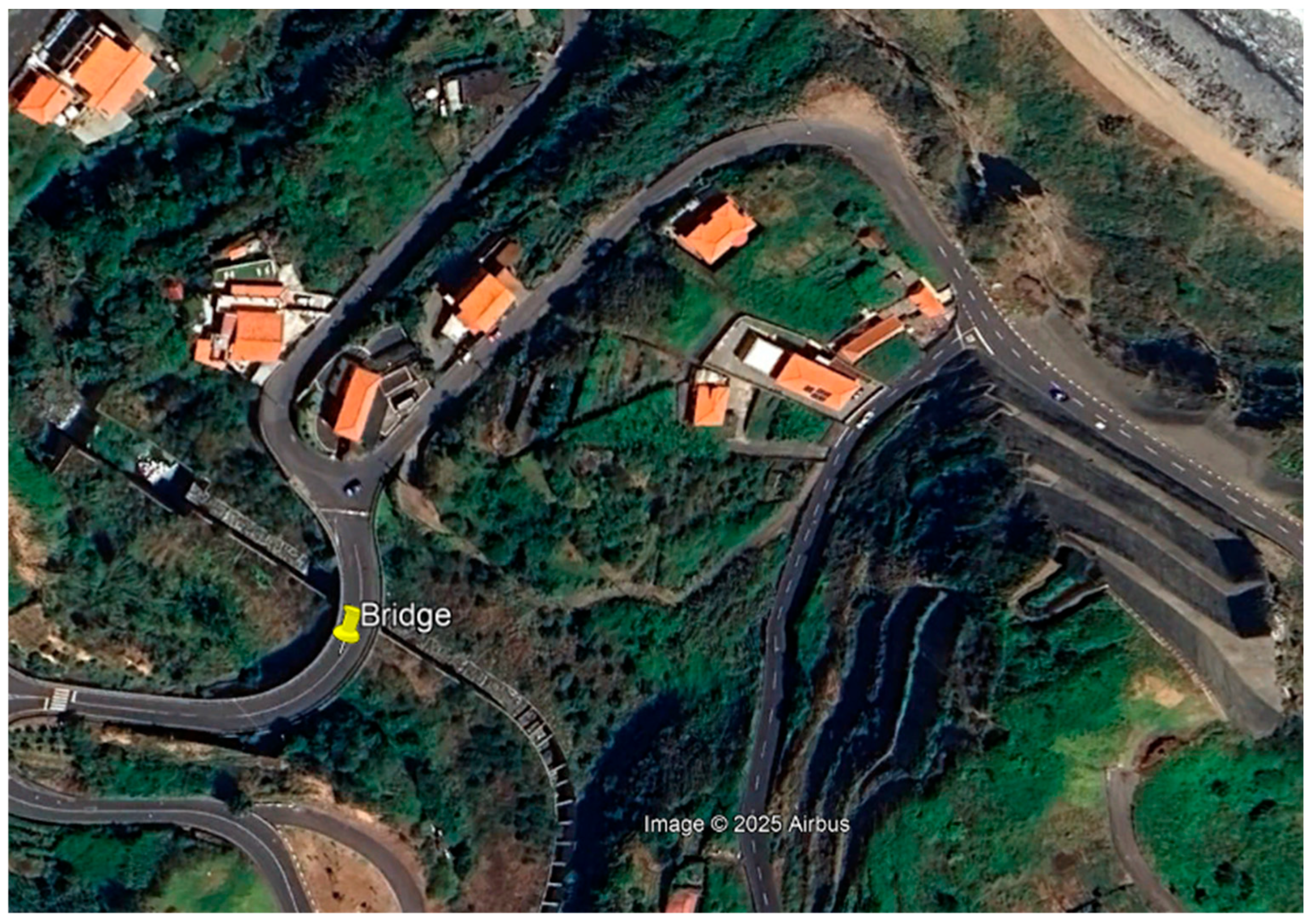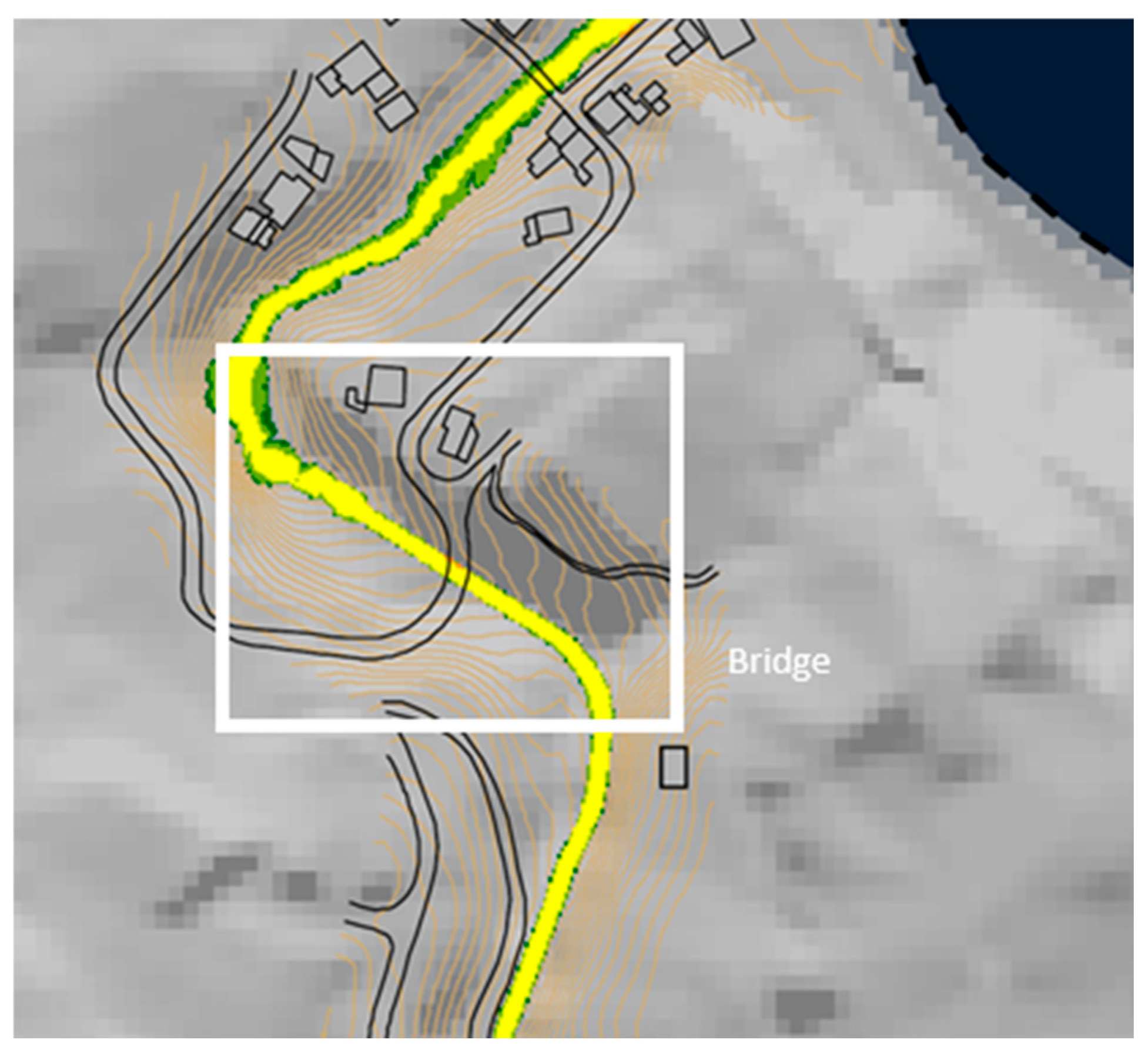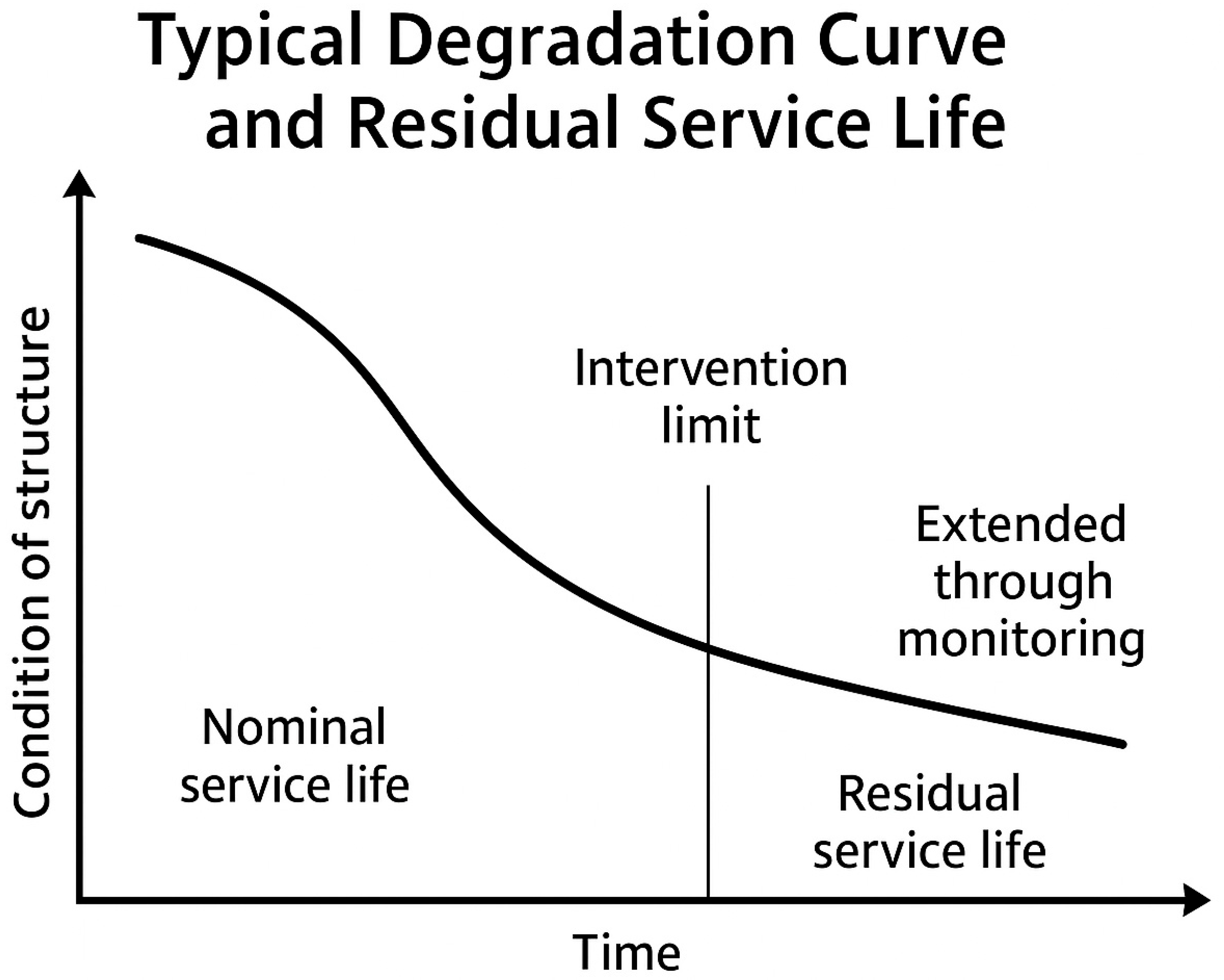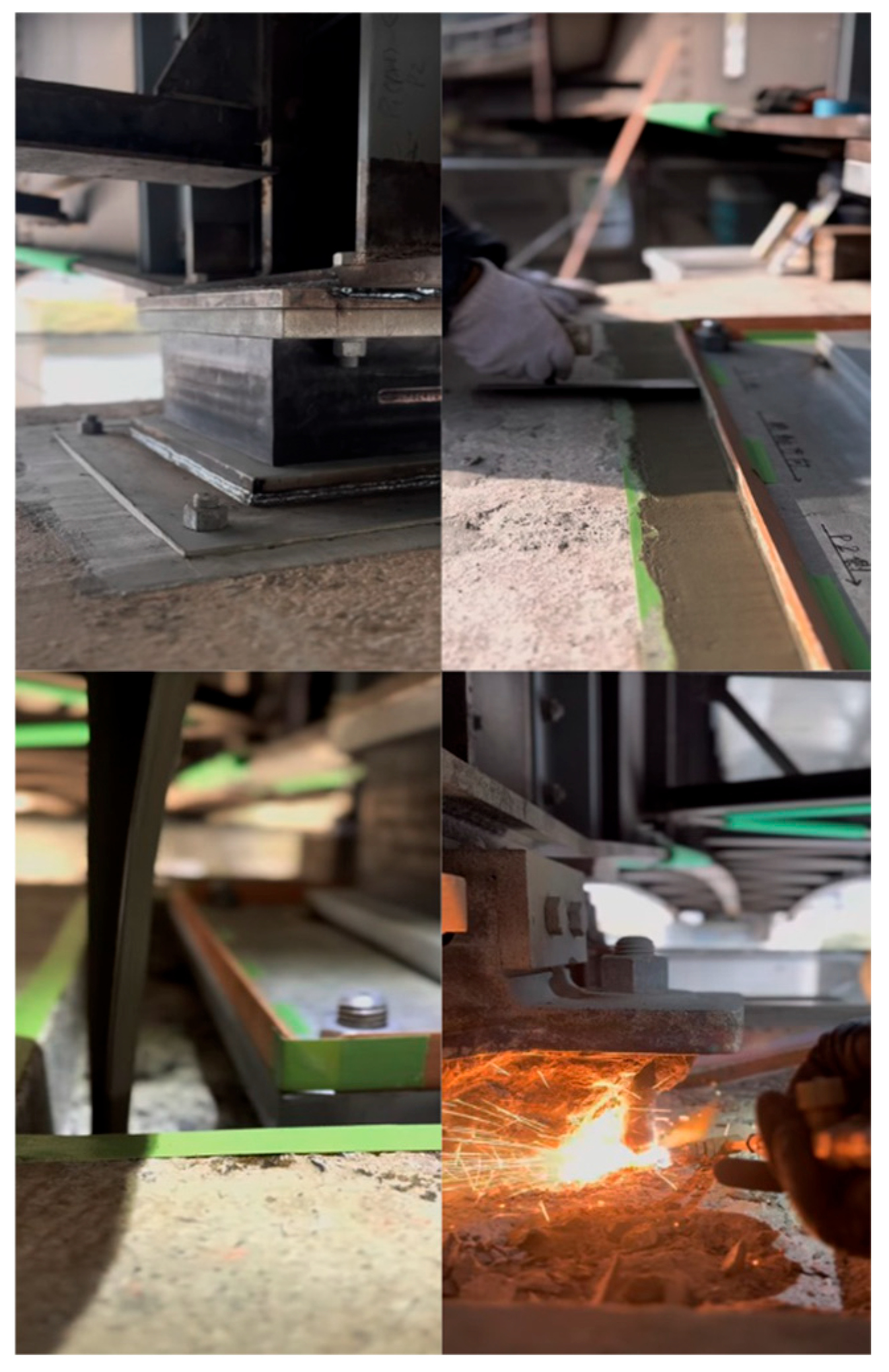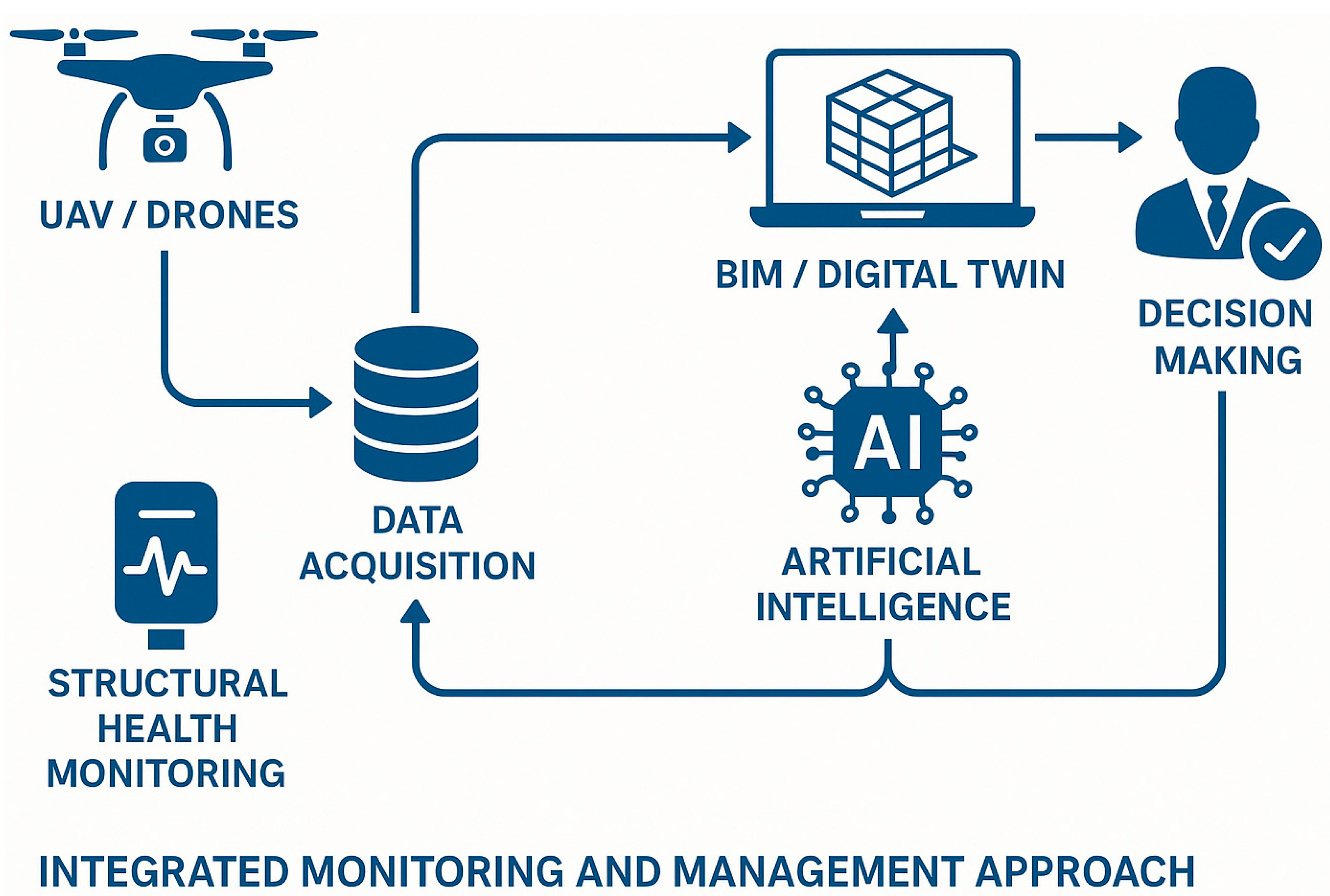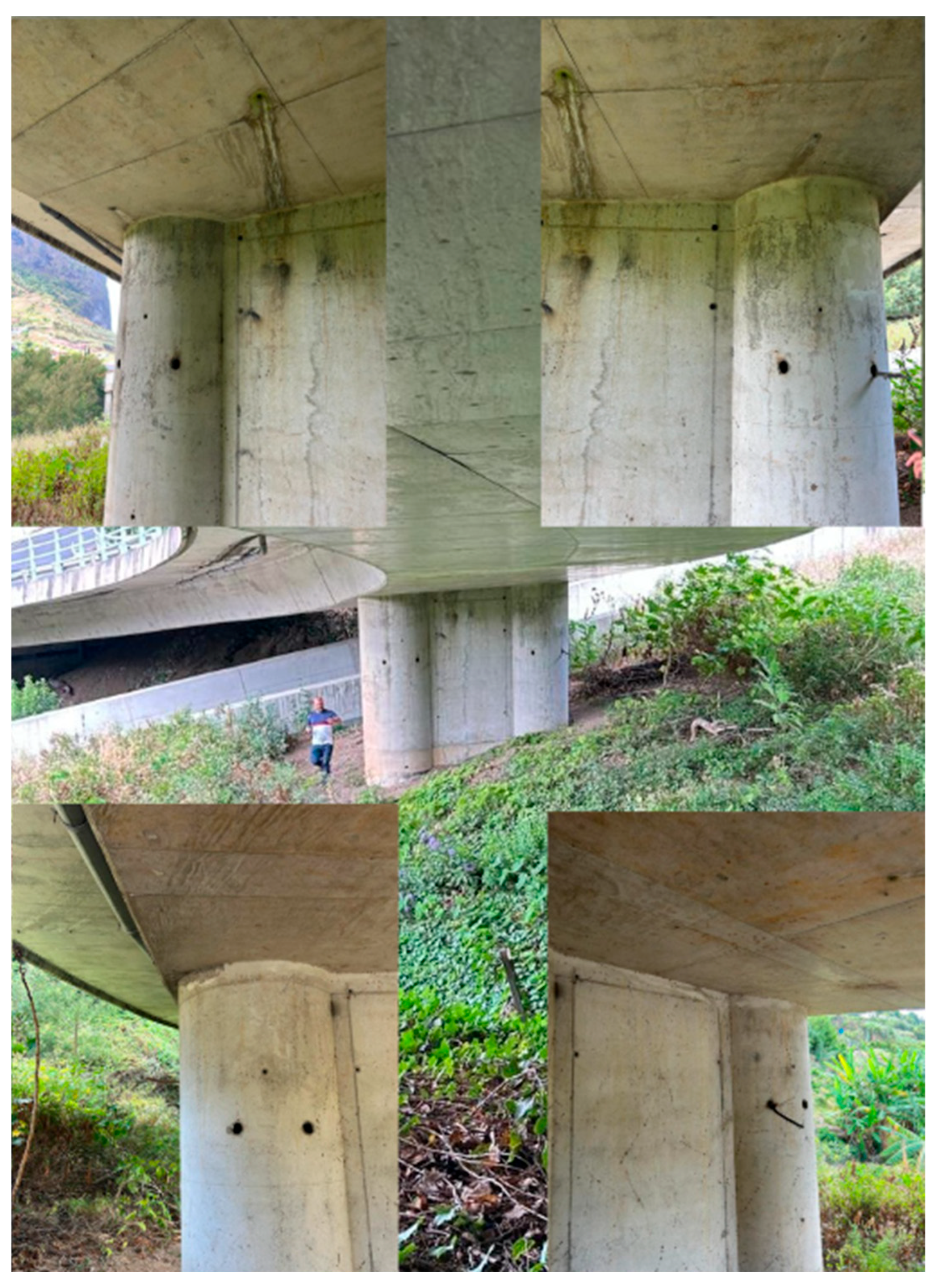1. Introduction
The Eduardo Caldeira Bridge, a vital infrastructure link in Machico on the island of Madeira, serves as a critical connection for local communities and regional transport [
1]. Despite its relatively recent construction (2003–2006), the bridge (
Figure 1) exhibited premature and severe degradation, particularly in its bearing devices, which were assigned the highest defect severity rating of Grade 5 (Critical). Initial investigations revealed that this accelerated deterioration was primarily caused by a combination of lateral deck displacements and inadequate maintenance strategies, exacerbated by the aggressive coastal environment in which the structure is located. The urgency of managing such infrastructure is underscored by recent global bridge collapses, which highlight the need for more robust and predictive management approaches.
Addressing the complex degradation mechanism of the Eduardo Caldeira Bridge required a diagnostic approach that went beyond routine visual inspection [
3,
4]. This study implements a multidisciplinary methodology, integrating detailed visual data with specific non-destructive testing (NDT) results to provide a comprehensive and quantitative assessment of the bridge’s structural health [
5]. This framework is used to analyse the root causes of the identified structural anomalies—including extensive cracking [
6,
7], concrete spalling [
8,
9], and crushed bearings [
10]—and to evaluate the associated risks to the bridge’s safety and operability based on established risk assessment methodologies [
11,
12].
This paper’s primary contribution is the presentation of a detailed case study that quantitatively links observed structural failures to their underlying causes, thereby providing a data-driven basis for the executed rehabilitation works, which included crack injection and complete bearing replacement [
13,
14,
15]. Furthermore, the study evaluates the practical application of emerging technologies—such as Artificial Intelligence (AI) [
8,
9] for defect analysis, Structural Health Monitoring (SHM) [
6,
7] for long-term tracking, and Building Information Modelling (BIM) [
10] for life-cycle management —to transition from a reactive to a predictive maintenance paradigm [
11,
12]. The findings are used to propose a sustainable management model aimed at optimizing future interventions and extending the bridge’s remaining service life in a cost-effective manner [
13,
14,
15].
The remainder of this article is structured as follows:
Section 2 details the evaluation and diagnosis methodology applied to the bridge.
Section 3 presents the risk analysis and the prioritization criteria for interventions.
Section 4 discusses the results and the advantages of the integrated technological approach.
Section 5 describes the specific findings of the case study and the real interventions performed. Finally,
Section 6 offers conclusions and recommendations for future infrastructure management.
2. Assessment and Diagnostic Methodology
The effective management of the Eduardo Caldeira Bridge required a systematic and rigorous methodology to accurately identify, assess, and propose mitigation measures for the observed structural degradation. Due to the complexity of the contributing factors—including structural displacements and environmental attack—a multifaceted diagnostic strategy was implemented. This strategy combined a review of historical data with a comprehensive suite of in situ inspections and laboratory tests to build a complete picture of the bridge’s condition.
2.1. Data Collection and Initial Assessment
A thorough understanding of the bridge’s condition began with an exhaustive review of all available project documentation. This included the original construction and design plans from the builder, Mota-Engil, which provided crucial data on materials, structural details, and waterproofing systems used between 2003 and 2006.
This phase was complemented by a detailed visual inspection of all accessible bridge elements. The inspection focused on identifying and mapping surface anomalies such as cracks, concrete spalling, deterioration of expansion joints and bearings, and evidence of water infiltration. This initial assessment was fundamental in pinpointing the most critical areas for further quantitative analysis, particularly the severe degradation of the bearing devices.
2.2. Quantitative Diagnosis: In Situ and Laboratory Testing
To supplement the visual inspection and obtain an objective, quantitative assessment of the structure’s condition, a series of non-destructive (NDT) and semi-destructive tests were performed. This testing program was designed to investigate the primary degradation mechanisms suspected of affecting the reinforced concrete.
Concrete core samples were extracted from key locations to perform a chloride penetration analysis. The objective was to determine the chloride content profile at different depths and verify if the concentration at the level of the steel reinforcement exceeded the critical threshold for initiating corrosion, as per standard methods [
16,
17]. To assess the immediate risk of ongoing corrosion, electrochemical potential measurements were taken across the concrete surface. While these measurements indicated that the overall risk of widespread active corrosion was less than 10%, they confirmed the high vulnerability of the structure to chloride-induced corrosion given the coastal environment [
16,
17].
Furthermore, a detailed crack detection and quantification (
Figure 2) survey was conducted. High-resolution digital images of the concrete surfaces were systematically captured and analysed to create a comprehensive crack map [
18]. This process, supported by intelligent identification technologies, allowed for the precise measurement of crack density, length, and width [
19]. These quantitative data were crucial for classifying the severity of the defects and informing the subsequent risk analysis. The data gathered from this comprehensive diagnostic process formed the foundation for the risk assessment and the targeted rehabilitation strategy detailed in the following sections [
20].
3. Risk Analysis and Intervention Proposals
Following the comprehensive diagnosis detailed in the previous chapter, a multi-hazard risk assessment was conducted for the Eduardo Caldeira Bridge. This crucial step aimed to classify the severity of the identified defects, understand the bridge’s vulnerability to external hazards, and develop a prioritized and effective intervention strategy to ensure its long-term safety and functionality.
3.1. Multi-Hazard Risk Profile of the Bridge
The risk profile for the Eduardo Caldeira Bridge was developed from a multifaceted perspective, combining the structure’s intrinsic vulnerability with its exposure to the unique environmental conditions of Madeira.
The structural and foundation risk was evaluated by quantifying the physical condition of the bridge’s components [
5]. This evaluation used a standardized “level of defectiveness” framework (
Table 1), which assigns a severity grade (G) based on the extent and intensity of detected defects [
3,
4]. While various pathologies like rebar corrosion and concrete cracking were observed, the analysis identified the bridge bearings as the most critical elements, with a defect level of G5 (Critical).
To better illustrate the types of structural degradation frequently encountered in concrete bridges,
Figure 3 presents a collage showcasing common defects such as various forms of cracking, rebar corrosion, and deterioration of bearing devices.
Given Madeira’s location in a seismic zone, the seismic risk was also assessed [
21]. The analysis followed the framework outlined in
Figure 4, considering the site-specific seismic hazard, expressed by Peak Ground Acceleration (PGA), and the local soil conditions at the bridge’s foundation [
21]. The bridge’s structural vulnerability was evaluated based on its design characteristics and materials, acknowledging that seismic reliability is a fundamental consideration for infrastructure in the region.
Finally, hydrogeological risks were considered, accounting for Madeira’s steep topography and the bridge’s location spanning the
Ribeira do Junçal. The integration of Geographic Information Systems (GIS) was used to assess hazards like floods and landslides. The bridge’s specific vulnerability to flooding is highlighted in the risk map shown in
Figure 5. The combination of these structural, seismic, and hydrogeological risks allowed for the assignment of an overall “Warning Class” for the bridge, indicating the urgency for intervention [
22].
3.2. Prioritization and Life-Cycle Management Strategy
In a context of limited financial resources, a rational prioritization of interventions is essential. For the Eduardo Caldeira Bridge, a set of priority criteria, outlined in
Table 2, was used to complement the “Warning Class” and justify the allocation of funds. Factors such as the bridge’s high structural risk grade (G5 for bearings) and its critical role in the local transport network were key considerations [
13].
The goal of the intervention strategy is to manage the bridge’s life cycle effectively. As illustrated in the typical degradation curve in
Figure 6, the proposed rehabilitation aims to restore the bridge’s condition and extend its safe service life well beyond its nominal design life, thereby optimizing life-cycle costs, especially given the maintenance challenges in maritime environments [
24].
3.3. Proposed Rehabilitation and Maintenance Plan
Based on the risk analysis, a targeted plan of interventions was developed for the Eduardo Caldeira Bridge to restore its structural integrity and enhance its long-term resilience.
The plan prioritized the repair of concrete defects and mitigation of corrosion. This involved the restoration of damaged concrete to re-establish the protective cover over the reinforcement steel, a process conceptually illustrated in
Figure 7. For the most critical defects, structural reinforcement measures were proposed, focusing on the replacement of the failed bearings (Grade G5) and reinforcement of the expansion joints [
4]. In cases of advanced degradation, the use of composite materials like CFRP was considered as a potential solution to enhance structural and seismic capacity [
5,
22].
Figure 8 shows examples of such reinforcement techniques.
To address the root causes of water-related damage, the plan included improvements to the drainage and protection systems [
4]. Proper maintenance and enhancement of these systems are crucial to prevent water and chloride ingress, thus protecting structural elements from future degradation, as shown in
Figure 9.
Finally, to shift towards a proactive management model, the implementation of predictive maintenance with SHM and AI was proposed [
6]. A continuous Structural Health Monitoring (SHM) plan is fundamental for early anomaly detection and predicting degradation progression [
8,
9]. By integrating SHM systems with AI-driven data analysis, future maintenance can be optimized, ensuring the sustainable development and resilience of critical infrastructures in coastal areas like
Machico [
11,
12].
4. Results and Discussion
This section presents the key findings from the diagnostic assessment of the Eduardo Caldeira Bridge and discusses their implications for the bridge’s management and future intervention planning. The results underscore the severity of the degradation and justify the need for an integrated and technologically advanced approach to infrastructure management in challenging coastal environments like Madeira.
4.1. Bridge Condition Assessment Results
The comprehensive diagnostic process yielded a quantitative assessment of the structural condition of the bridge’s main components. The “level of defectiveness” for each component was classified according to the severity grade (G) framework, with the results summarized in
Table 3.
The data in
Table 3 reveals a critical finding: while major components like the deck, railings, and superstructure were in good condition (G1–G2), the bridge’s functionality was severely compromised by the critical state of its bearings (G5) and the severe defects in its expansion joints (G4). This highly localized but critical degradation pattern was the primary driver for the urgent rehabilitation works and highlighted a significant vulnerability in the structure.
4.2. Discussion of Findings and Implications
The assessment results provide a clear narrative of the bridge’s pathology. The critical failure of the bearings and joints, when contrasted with the good condition of the rest of the structure, strongly suggests that the primary cause of degradation was not widespread material deterioration but rather specific mechanical and environmental factors. This aligns with the initial diagnosis that pointed to lateral deck displacements as a key contributing factor, a problem that disproportionately affects bearings and joints.
This discovery highlights the limitations of purely periodic or traditional inspection methods, which may fail to capture the underlying dynamics of such a failure. The severity of the localized defects (G5) justifies the need for a more advanced and proactive management strategy. The integrated monitoring and management model, illustrated in
Figure 10, emerges from the lessons learned in this case study. It proposes a shift from reactive repairs to a predictive, data-driven approach where continuous monitoring (SHM) [
6,
7], advanced data analysis (AI) [
8,
9], and life-cycle management (BIM) [
10,
15] are used to anticipate failures before they become critical.
However, implementing such a technologically advanced model for infrastructures in the specific context of Machico and Madeira presents distinct challenges. High initial costs for SHM systems and BIM platforms, and the need for specialized professional training in data science and AI, are significant barriers. Furthermore, the island’s aggressive coastal environment intensifies material degradation, while its unique topography exposes infrastructures to hydrogeological risks, making the need for resilient and predictive maintenance even more critical [
10,
11]. Overcoming these challenges is fundamental to ensuring the long-term safety and sustainable development of the island’s essential transport network [
20,
21,
24].
5. Case Study: The Eduardo Caldeira Bridge
This section presents the detailed case study of the Eduardo Caldeira Bridge. It synthesizes the site-specific context, the diagnosis of the observed pathologies, and the real-world interventions that were implemented. This narrative serves as a practical application of the preceding analysis and highlights the challenges of managing critical infrastructure in the complex geological and environmental setting of Madeira.
5.1. Site Context: Geology and Infrastructure
The Eduardo Caldeira Bridge spans the Ribeira do Junçal in Porto da Cruz, a location characterized by a demanding hydrographic basin (
Figure 11). The geological context is a primary factor in the bridge’s behaviour. According to the Geological Map of Madeira Island, the area is situated on formations of the Superior Volcanic Complex (CVS2), consisting mainly of basaltic and argillaceous tuffs with volcanic bombs [
26].
A subsurface investigation identified three distinct geotechnical zones (ZG) influencing the bridge’s foundation:
Geotechnical Zone 3 (ZG3): The superficial zone, consisting of argillaceous fills and/or cover deposits. This zone is associated with the construction of the regional road and the Porto da Cruz cemetery. SPT values for these fills ranged from 3 to 6 blows. The thickness of the fills varies between 1 and 5 m [
26].
Geotechnical Zone 2 (ZG2): This zone corresponds to slope deposits, which are composed of basaltic blocks in an argillaceous matrix. SPT values in the matrix ranged from 2 to 12 blows, although most tests resulted in “negas” (60 blows without full penetration) due to the presence of basalt blocks. The base of these deposits, which is believed to be the instability surface, occurs at depths between 9.2 and 24.2 m [
26].
Geotechnical Zone 1 (ZG1): The lowest zone, representing the volcanic massif with intercalations of basalts, vesicular basalts, and volcanic tuffs. The basalts were found to be fractured, with alteration grades ranging from moderately altered (W3) to decomposed (W5). RQD values were highly variable, with lower values (below 50%) being more representative of the observed basalts [
26].
This geological stratification, particularly the potential instability surface between ZG1 and ZG2, is a critical consideration for the bridge’s substructure. To manage this risk, a retaining wall at the south abutment was constructed with self-drilling anchors, jet-grouting columns, and geodrains, reflecting the complexity of the site [
27].
5.2. Diagnosis of Structural Degradation
As summarized in the assessment results (
Table 3, Chapter 4), the bridge suffered from highly localized but critical degradation. A detailed site inspection on 21 July 2025, revealed a clear pattern of damage linked to the site conditions.
The most severe damage was observed on the northernmost pier, where the bearing elements were effectively destroyed (
Figure 12). This critical failure is directly attributed to the challenging soil characteristics and potential instability at this location, leading to movements that exceeded the bearings’ capacity.
In stark contrast, the central pier was found to be in excellent condition, showing no visible problems (
Figure 13). This provided a crucial benchmark, indicating that the original concrete structure was performing well where foundation conditions were stable.
The southernmost pier’s support mechanisms, while not destroyed, exhibited significant surface oxidation (
Figure 14). This degradation was attributed to inadequate drainage, which was further evidenced by visible rainwater runoff stains on the underside of the bridge deck (
Figure 15). These findings highlight a secondary degradation mechanism: prolonged water exposure leading to corrosion, a common but critical maintenance challenge.
5.3. Implemented Rehabilitation Strategy
In response to the diagnosis, a targeted rehabilitation strategy was executed to restore the bridge’s safety and functionality. The interventions were a direct consequence of the identified defects and provided a proactive approach to asset management in Machico. The key implemented works include:
Substructure and Bearing Replacement: The most critical intervention was addressing the failed bearings. This required deck lifting operations at both abutments, costing €17,700.00 per abutment. The G5-rated bearings were completely replaced with new fixed and unidirectional pot bearings. To address the underlying stability issues, work was performed on 17 permanent anchorages in the adjacent containment wall, and the deck was recentred over the south abutment at a cost of €21,200.00.
Concrete and Joint Repair: Localized deep concrete repairs (2.5 m2) were performed on degraded areas. Fissures in the abutments were sealed and injected, covering 30 linear meters of cracks of varying widths. The G4-rated expansion joints were fully replaced with new ones over a total length of 21 linear meters.
Surface and System Maintenance: General cleaning of exposed concrete surfaces (172 m2) was carried out, along with specific maintenance and cleaning of the drainage system to mitigate the water-related degradation observed.
6. Conclusions
This study of the Eduardo Caldeira Bridge provided an in-depth analysis of a critical infrastructure asset facing severe, premature degradation. The investigation concludes that the bridge’s critical condition was not caused by widespread material deterioration, but rather by a highly localized failure of its bearing devices (rated G5—Critical). This failure was driven by a complex interaction between the unique and challenging geotechnical conditions of the site and the structural dynamics of the bridge, namely, the observed lateral displacements.
The multidisciplinary diagnostic approach, which integrated visual data with quantitative non-destructive testing, was fundamental in pinpointing this specific failure mechanism. By contrasting the destroyed bearings with the otherwise good condition of the main superstructure, the analysis moved beyond a simple inventory of defects to a root cause diagnosis. This data-driven understanding was essential for developing the targeted and urgent rehabilitation strategy that was subsequently implemented, which focused on replacing the bearings and mitigating the underlying stability issues.
The primary contribution of this paper is twofold. First, it presents a detailed, real-world case study of a complex and critical bridge failure mode, providing valuable data and insights for engineers and asset managers dealing with similar structures in challenging environments. Second, the findings from this bridge underscore the significant limitations of traditional, periodic inspection regimes in detecting and predicting such complex, mechanics-driven failures. The study therefore makes a strong, evidence-based case for the adoption of an integrated and predictive management model. This proposed model leverages modern technologies like Structural Health Monitoring (SHM), Artificial Intelligence (AI), and Building Information Modelling (BIM) not as a theoretical novelty, but as a necessary evolution to ensure structural longevity and safety.
Future work should focus on the long-term implementation and validation of this predictive model on the now-rehabilitated Eduardo Caldeira Bridge. This would allow for the collection of continuous performance data to refine degradation models and quantify the long-term cost–benefit of a proactive versus a reactive maintenance approach. Ultimately, this study demonstrates that technologically advanced, data-driven asset management is not merely an option but an essential requirement for ensuring the safety, resilience, and sustainability of critical infrastructure in an era of increasing environmental and operational demands.
Author Contributions
Conceptualization, R.A. and S.L.; methodology, R.A.; validation, S.L., J.C. and J.M.N.G.; formal analysis, S.L.; investigation, R.A.; resources, R.A.; writing—original draft preparation, R.A.; writing—review and editing, R.A., S.L., J.C. and J.M.N.G.; visualization, R.A.; supervision, S.L.; project administration, S.L.; funding acquisition, R.A. All authors have read and agreed to the published version of the manuscript.
Funding
This research was funded by Machico City Council and the Consejería de Economía, Ciencia y Agenda Digital from Junta de Extremadura, and by the European Regional Development Fund of the European Union through the reference grants GR21135.
Institutional Review Board Statement
Not applicable.
Informed Consent Statement
Not applicable.
Data Availability Statement
We are committed to promoting transparency and reproducibility in research. The data supporting the results reported in this article are available in accordance with MDPI’s data sharing policies. If no new data were created or if data availability is restricted due to privacy or ethical considerations, we affirm that this statement is still required for transparency. We have provided detailed information on how to access or obtain the data whenever possible, and we are willing to provide additional information upon request to ensure the reproducibility of our research.
Acknowledgments
We want to thank the project “ESDGs! Sustainable Development Goals in Education in Action!” (2021-1-CZ01-KA220-HED-000031187) for providing the essential financial and logistical support for the completion of this research. Without the funding and resources made available by this project, this study would not have been possible. Special thanks are due to Machico City Council and the Consejería de Economía, the Ciencia y Agenda Digital from Junta de Extremadura, and the European Regional Development Fund of the European Union for the reference grants GR21135 and for the generous financial support granted, which made this study and article publication possible. Their significant contribution was fundamental to the success of this research project. We would like to express our sincere gratitude for their continuous support in advancing scientific knowledge within the field of civil construction. Without their sponsorship, this publication would not have been possible.
Conflicts of Interest
The authors declare no conflicts of interest.
Abbreviations
The following abbreviations are used in this manuscript:
| CMM | Machico City Council |
| DECG | Department of Civil Engineering and Geology |
| FCEE | Faculty of Exact Sciences and Engineering |
| UMa | University of Madeira |
| CITUR | Research Centre for Tourism Development and Innovation |
| IPP | Polytechnic Institute of Portalegre |
| MAOT | Research Group on Environment and Spatial Planning |
| RISCO | Civil Engineering Department of University of Aveiro |
| SHM | Structural Health Monitoring |
| NDT | Non-Destructive Testing |
| AI | Artificial Intelligence |
| BIM | Building Information Modelling |
| UAVs | Unmanned Aerial Vehicles |
| GPR | Ground Penetrating Radar |
| IRT | Infrared Thermography |
| PGA | Peak Ground Acceleration |
| GIS | Geographic Information Systems |
| ADT | Average Daily Traffic |
| CFRP | Carbon Fiber-Reinforced Polymer |
| ER 110 | Regional Road 110 |
| PGRI | Flood Risk Management Plan |
References
- Santos, A.; Bonatte, M.; Carvalho Neto, J.; Sousa, H.; Bittencourt, T.; Matos, J. Avaliação da Segurança de Pontes Existentes por Meio da Análise de Confiabilidade-Estudos de Casos. Lisboa: [s.n.], nov. 2022, pp. 1623–1638. Available online: https://www.researchgate.net/publication/371762511_Metodologia_de_avaliacao_estrutural_para_longarinas_de_pontes_de_concreto_armado_sem_dados_de_projeto_uma_analise_probabilistica (accessed on 20 June 2025).
- Google Earth. Aerial View of Eduardo Caldeira Bridge, Machico. Retrieved from Google Earth Pro Software. 2023. [Google Scholar]
- Gonçalves, A.; Custódio, J. As Reacções Expansivas Internas no Betão. Prevenção dos Riscos (Internal Expansive Reactions in Concrete. Risks Prevention). 2010. Available online: https://www.researchgate.net/publication/256521147_As_reaccoes_expansivas_internas_no_betao_Prevencao_dos_riscos_Internal_Expansive_Reactions_in_Concrete_Risks_prevention (accessed on 18 June 2025).
- Poças, R. Gestão do Ciclo de Vida de Pontes. 2009. Available online: https://www.researchgate.net/publication/277167389_Gestao_do_ciclo_de_vida_de_pontes (accessed on 13 August 2025).
- Medeiros, A.; Sá, M.; Filho, J.; Anjos, M. Aplicação de metodologias de inspeção em ponte de concreto armado. Ambiente Construído 2020, 20, 687–702. [Google Scholar] [CrossRef]
- Byfield, R.; Shabaka, A.; Molina Vargas, M.; Tansel, I. Intelligent Hybrid SHM-NDT Approach for Structural Assessment of Metal Components. Infrastructures 2025, 10, 174. [Google Scholar] [CrossRef]
- Mousa, M.A.; Yussof, M.M.; Udi, U.J.; Nazri, F.M.; Kamarudin, M.K.; Parke, G.A.R.; Assi, L.N.; Ghahari, S.A. Application of Digital Image Correlation in Structural Health Monitoring of Bridge Infrastructures: A Review. Infrastructures 2021, 6, 176. [Google Scholar] [CrossRef]
- Althaqafi, E.; Chou, E. Developing Bridge Deterioration Models Using an Artificial Neural Network. Infrastructures 2022, 7, 101. [Google Scholar] [CrossRef]
- Plevris, V.; Papazafeiropoulos, G. AI in Structural Health Monitoring for Infrastructure Maintenance and Safety. Infrastructures 2024, 9, 225. [Google Scholar] [CrossRef]
- Abbasnejad, B.; Soltani, S.; Ahankoob, A.; Kaewunruen, S.; Vahabi, A. Industry 4.0 Technologies for Sustainable Transportation Projects: Applications, Trends, and Future Research Directions in Construction. Infrastructures 2025, 10, 104. [Google Scholar] [CrossRef]
- Villarino, A.; Valenzuela, H.; Antón, N.; Domínguez, M.; Méndez Cubillos, X.C. UAV Applications for Monitoring and Management of Civil Infrastructures. Infrastructures 2025, 10, 106. [Google Scholar] [CrossRef]
- Su, Y.; Song, Y.; Zhan, Z.; Bi, Z.; Zhou, B.; Yu, Y.; Song, Y. Research on Intelligent Identification Technology for Bridge Cracks. Infrastructures 2025, 10, 102. [Google Scholar] [CrossRef]
- Valkonen, A.; Glisic, B. Structural Health Monitoring-Based Bridge Lifecycle Extension: Survival Analysis and Monte Carlo-Based Quantification of Value of Information. Infrastructures 2023, 8, 158. [Google Scholar] [CrossRef]
- Cardoso, M. Metodologia de Avaliação da Segurança Estrutural de Pontes de Concreto Armado. Ph.D. Thesis, Universidade Federal de Viçosa, Minas Geria, Brasil, October 2022. [Google Scholar] [CrossRef]
- Medvediev, K.; Kharchenko, A.; Stakhova, A.; Yevseichyk, Y.; Tsybulskyi, V.; Bekö, A. Methodology for Assessing the Technical Condition and Durability of Bridge Structures. Infrastructures 2024, 9, 16. [Google Scholar] [CrossRef]
- Liao, J.; Wang, Y.; Sun, X.; Wang, Y. Chloride Penetration of Surface-Coated Concrete: Review and Outlook. Materials 2024, 17, 4121. [Google Scholar] [CrossRef]
- Rout, M.; Biswas, S.; Shubham, K.; Sinha, A. A systematic review on performance of reclaimed asphalt pavement (RAP) as sustainable material in rigid pavement construction: Current status to future perspective. J. Build. Eng. 2023, 76, 107253. [Google Scholar] [CrossRef]
- Zhou, L.; Jia, H.; Jiang, S.; Xu, F.; Tang, H.; Xiang, C.; Wang, G.; Zheng, H.; Chen, L. Multi-Scale Crack Detection and Quantification of Concrete Bridges Based on Aerial Photography and Improved Object Detection Network. Buildings 2025, 15, 1117. [Google Scholar] [CrossRef]
- Munawar, H.S.; Hammad, A.W.A.; Haddad, A.; Soares, C.A.P.; Waller, S.T. Image-Based Crack Detection Methods: A Review. Infrastructures 2021, 6, 115. [Google Scholar] [CrossRef]
- Pu, R.; Ren, G.; Li, H.; Jiang, W.; Zhang, J.; Qin, H. Autonomous Concrete Crack Semantic Segmentation Using Deep Fully Convolutional Encoder–Decoder Network in Concrete Structures Inspection. Buildings 2022, 12, 2019. [Google Scholar] [CrossRef]
- Alves, R.; Lousada, S.; Cabezas, J.; Gómez, J.M.N. The Importance of the Strategic Urban Rehabilitation Plan in the Sustainable Development of the Municipality of Machico. Sustainability 2022, 14, 16816. [Google Scholar] [CrossRef]
- Alves, R.; Lousada, S.; Cabezas, J.; Gómez, J.M.N. Local Housing Strategy: Analysis of Importance and Implementation in Machico Municipality, Madeira. Land 2023, 12, 1778. [Google Scholar] [CrossRef]
- Governo Regional da Madeira. Plano de Gestão de Riscos de Inundações (PGRI). 2017. Available online: https://pgri-ram.madeira.gov.pt/. (accessed on 5 July 2025).
- Alves, R.; Lousada, S.; Naranjo Gómez, J.M.; Cabezas, J. Maintenance Challenges in Maritime Environments and the Impact on Urban Mobility: Machico Stayed Bridge. Infrastructures 2024, 9, 180. [Google Scholar] [CrossRef]
- Adachi Industry Co., Ltd. Bridge Repair Solutions. 2024. Available online: www.i-adachi.co.jp. (accessed on 5 July 2025).
- Governo Regional da Madeira, Secretaria Regional do Ambiente e Recursos Naturais, Universidade da Madeira. Carta Geológica da Ilha da Madeira, Sheet B, 1:50,000 Scale; Universidade da Madeira: Funchal, Portugal, 2015. [Google Scholar]
- Mota-Engil. Eduardo Caldeira Bridge Project and Construction Drawings; Unpublished Technical Drawings and Project Data; Mota-Engil: Porto, Portugal, 2006. [Google Scholar]
| Disclaimer/Publisher’s Note: The statements, opinions and data contained in all publications are solely those of the individual author(s) and contributor(s) and not of MDPI and/or the editor(s). MDPI and/or the editor(s) disclaim responsibility for any injury to people or property resulting from any ideas, methods, instructions or products referred to in the content. |
© 2025 by the authors. Licensee MDPI, Basel, Switzerland. This article is an open access article distributed under the terms and conditions of the Creative Commons Attribution (CC BY) license (https://creativecommons.org/licenses/by/4.0/).
